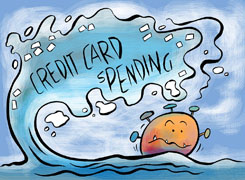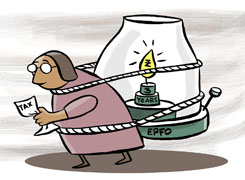Am I stuck in debt even with a high income?
Ramalingam Kalirajan |10881 Answers |Ask -Follow
Mutual Funds, Financial Planning Expert - Answered on Aug 30, 2024
He has an MBA in finance from the University of Madras and is a certified financial planner.
He is the director and chief financial planner at Holistic Investment, a Chennai-based firm that offers financial planning and wealth management advice.... more

Hello gurus! I am 41, I earn 28 lakhs per month in Chennai. I have a debt of 1.75 lakhs each month. This consist of HL, CL and PL. How can I reduce it quickly?
Evaluating Your Debt Structure
Before diving into debt reduction, it’s essential to understand your debt structure. Each loan type has different interest rates and repayment terms.
Home Loan (HL): Generally, home loans have lower interest rates and longer tenures. They also offer tax benefits, which can reduce the effective interest rate.
Car Loan (CL): Car loans typically have higher interest rates than home loans. They are secured loans, but the asset (car) depreciates over time, making this debt less favorable.
Personal Loan (PL): Personal loans often have the highest interest rates. They are unsecured, meaning they don’t have collateral backing them. Reducing personal loans should be a priority due to their high cost.
Prioritizing Debt Repayment
To reduce your debt quickly, you should prioritize which loans to pay off first. This strategy is known as the debt avalanche or debt snowball method.
Debt Avalanche Method: Focus on paying off the loan with the highest interest rate first. This approach saves you money on interest in the long run.
Debt Snowball Method: Pay off the smallest loan amount first. This method provides psychological benefits by quickly reducing the number of loans you have.
Given your situation, the debt avalanche method may be more effective due to the high interest rates associated with personal loans.
Creating a Debt Repayment Plan
Now, let’s create a plan to tackle your debt. A structured approach will help you stay focused and achieve your goal faster.
Assess Your Monthly Budget: Start by assessing your monthly budget. Calculate your essential expenses, including EMIs, household expenses, and other commitments.
Identify Surplus Income: With a high monthly income of Rs. 28 lakhs, you should have surplus income after meeting essential expenses. This surplus can be directed towards extra debt payments.
Increase EMI Payments: Consider increasing your EMI payments on the loan with the highest interest rate. Even a small increase can significantly reduce your loan tenure and interest burden.
Make Lump Sum Payments: Whenever you receive a bonus, incentive, or any extra income, use it to make a lump sum payment towards your debt. This will reduce your principal amount and interest burden.
Refinancing or Restructuring Loans
Another strategy to reduce your debt quickly is to refinance or restructure your loans.
Home Loan Balance Transfer: If your home loan interest rate is higher than the current market rates, consider a home loan balance transfer. This can lower your EMI and interest payments.
Consolidate High-Interest Loans: If possible, consolidate your high-interest personal loans into a single loan with a lower interest rate. This can simplify repayment and reduce your overall interest cost.
Negotiating with Lenders: Sometimes, lenders are willing to negotiate terms, especially if you have a good credit history. Try negotiating for lower interest rates or extended loan tenures to reduce your monthly burden.
Building an Emergency Fund
Before aggressively paying off your debt, ensure you have an emergency fund in place. This fund should cover 6-12 months of living expenses. It acts as a safety net in case of unexpected expenses, preventing you from taking on more debt.
Controlling Expenses
Reducing your debt quickly requires discipline in managing your expenses.
Track Your Spending: Regularly track your spending to identify areas where you can cut back. Redirect these savings towards debt repayment.
Avoid New Debt: Resist the temptation to take on new debt, especially for discretionary spending. Focus on clearing your existing debt first.
Using Investments Wisely
You may have investments that are not performing well or are not aligned with your financial goals.
Redeem Underperforming Investments: Consider redeeming underperforming or non-essential investments to make a lump sum payment towards your debt. This can accelerate your debt reduction process.
Avoid Redeeming High-Performing Investments: On the other hand, avoid redeeming investments that are performing well and aligned with your long-term goals.
Role of Insurance
Having adequate insurance is crucial when managing debt. It protects your family’s financial future in case of unforeseen circumstances.
Life Insurance: Ensure you have enough life insurance coverage to pay off your debts if something happens to you. This will prevent your family from inheriting your debt burden.
Health Insurance: Having comprehensive health insurance is essential. It can prevent unexpected medical expenses from disrupting your debt repayment plan.
Monitoring and Adjusting Your Plan
Your financial situation may change over time. Regularly monitor your debt repayment plan and adjust it as needed.
Review Your Progress: Every few months, review your progress. Are you reducing your debt as planned? If not, identify the challenges and adjust your strategy.
Stay Disciplined: Reducing debt quickly requires discipline. Stay committed to your plan, even if it means making short-term sacrifices for long-term benefits.
Final Insights
Reducing your debt quickly is achievable with a well-structured plan and disciplined approach. Focus on paying off high-interest loans first, increase your EMI payments, and make lump sum payments whenever possible.
Refinancing or restructuring your loans can also help reduce your monthly burden. Ensure you have an emergency fund in place and adequate insurance coverage to protect your financial future.
Best Regards,
K. Ramalingam, MBA, CFP,
Chief Financial Planner,
www.holisticinvestment.in
You may like to see similar questions and answers below
Ramalingam Kalirajan |10881 Answers |Ask -Follow
Mutual Funds, Financial Planning Expert - Answered on May 24, 2024
Ramalingam Kalirajan |10881 Answers |Ask -Follow
Mutual Funds, Financial Planning Expert - Answered on Jun 11, 2024
Ramalingam Kalirajan |10881 Answers |Ask -Follow
Mutual Funds, Financial Planning Expert - Answered on Jul 22, 2024
Ramalingam Kalirajan |10881 Answers |Ask -Follow
Mutual Funds, Financial Planning Expert - Answered on Oct 18, 2024
Milind Vadjikar | Answer |Ask -Follow
Insurance, Stocks, MF, PF Expert - Answered on Nov 06, 2024
Kanchan Rai |646 Answers |Ask -Follow
Relationships Expert, Mind Coach - Answered on Dec 12, 2025
Ravi Mittal |677 Answers |Ask -Follow
Dating, Relationships Expert - Answered on Dec 12, 2025
Ramalingam Kalirajan |10881 Answers |Ask -Follow
Mutual Funds, Financial Planning Expert - Answered on Dec 12, 2025
Ramalingam Kalirajan |10881 Answers |Ask -Follow
Mutual Funds, Financial Planning Expert - Answered on Dec 12, 2025
Reetika Sharma |423 Answers |Ask -Follow
Financial Planner, MF and Insurance Expert - Answered on Dec 12, 2025
Reetika Sharma |423 Answers |Ask -Follow
Financial Planner, MF and Insurance Expert - Answered on Dec 12, 2025
Reetika Sharma |423 Answers |Ask -Follow
Financial Planner, MF and Insurance Expert - Answered on Dec 12, 2025
Reetika Sharma |423 Answers |Ask -Follow
Financial Planner, MF and Insurance Expert - Answered on Dec 12, 2025
Reetika Sharma |423 Answers |Ask -Follow
Financial Planner, MF and Insurance Expert - Answered on Dec 12, 2025
Mayank Chandel |2572 Answers |Ask -Follow
IIT-JEE, NEET-UG, SAT, CLAT, CA, CS Exam Expert - Answered on Dec 11, 2025

























